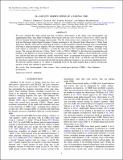Files in this item
Hα and EUV observations of a partial CME
Item metadata
| dc.contributor.author | Christian, Damian J. | |
| dc.contributor.author | Jess, David B. | |
| dc.contributor.author | Antolin, Patrick | |
| dc.contributor.author | Mathioudakis, Mihalis | |
| dc.date.accessioned | 2017-02-14T11:30:13Z | |
| dc.date.available | 2017-02-14T11:30:13Z | |
| dc.date.issued | 2015-05-12 | |
| dc.identifier | 248969636 | |
| dc.identifier | 5db3e463-9420-40bc-bb65-f1fb79cd4585 | |
| dc.identifier | 84929996408 | |
| dc.identifier.citation | Christian , D J , Jess , D B , Antolin , P & Mathioudakis , M 2015 , ' Hα and EUV observations of a partial CME ' , Astrophysical Journal , vol. 804 , 147 . https://doi.org/10.1088/0004-637X/804/2/147 | en |
| dc.identifier.issn | 0004-637X | |
| dc.identifier.other | BibCode: 2015ApJ...804..147C | |
| dc.identifier.uri | https://hdl.handle.net/10023/10291 | |
| dc.description.abstract | We have obtained Hα high spatial and time resolution observations of the upper solar chromosphere and supplemented these with multi-wavelength observations from the Solar Dynamics Observatory (SDO) and the Hinode Extreme-ultraviolet Imaging Spectrometer. The Hα observations were conducted on 2012 February 11 with the Hydrogen-Alpha Rapid Dynamics Camera instrument at the National Solar Observatory's Dunn Solar Telescope. Our Hα observations found large downflows of chromospheric material returning from coronal heights following a failed prominence eruption. We have detected several large condensations ("blobs") returning to the solar surface at velocities of ≈200 km s−1 in both Hα and several SDO Atmospheric Imaging Assembly band passes. The average derived size of these "blobs" in Hα is 500 by 3000 km2 in the directions perpendicular and parallel to the direction of travel, respectively. A comparison of our "blob" widths to those found from coronal rain, indicate that there are additional, smaller, unresolved "blobs" in agreement with previous studies and recent numerical simulations. Our observed velocities and decelerations of the "blobs" in both Hα and SDO bands are less than those expected for gravitational free-fall and imply additional magnetic or gas pressure impeding the flow. We derived a kinetic energy of ≈2 orders of magnitude lower for the main eruption than a typical coronal mass ejection, which may explain its partial nature. | |
| dc.format.extent | 9 | |
| dc.format.extent | 2010309 | |
| dc.language.iso | eng | |
| dc.relation.ispartof | Astrophysical Journal | en |
| dc.rights | © 2015 The American Astronomical Society. All rights reserved. This work is made available online in accordance with the publisher’s policies. This is the final published version of the work, which was originally published at: https://dx.doi.org/10.1088/0004-637X/804/2/147 | en |
| dc.subject | Sun: chromosphere | en |
| dc.subject | Sun: corona | en |
| dc.subject | Sun: coronal mass ejections: CMEs | en |
| dc.subject | Sun: filaments | en |
| dc.subject | Prominences | en |
| dc.subject | QB Astronomy | en |
| dc.subject | QC Physics | en |
| dc.subject | NDAS | en |
| dc.subject.lcc | QB | en |
| dc.subject.lcc | QC | en |
| dc.title | Hα and EUV observations of a partial CME | en |
| dc.type | Journal article | en |
| dc.contributor.institution | University of St Andrews.Applied Mathematics | en |
| dc.identifier.doi | 10.1088/0004-637X/804/2/147 | |
| dc.description.status | Peer reviewed | en |
| dc.identifier.url | http://adsabs.harvard.edu/abs/2015ApJ...804..147C | en |
This item appears in the following Collection(s)
Items in the St Andrews Research Repository are protected by copyright, with all rights reserved, unless otherwise indicated.

